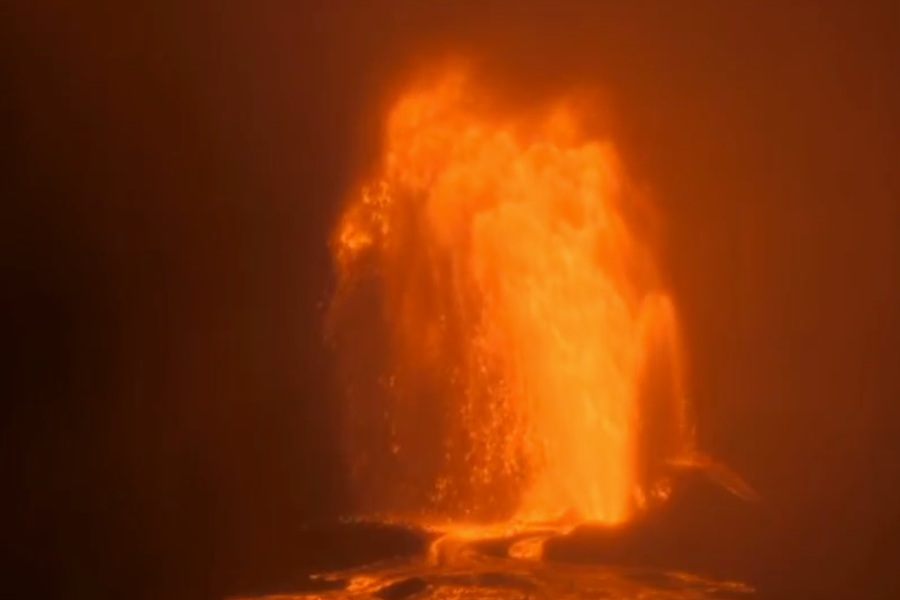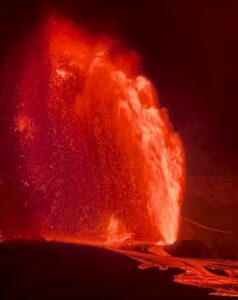
The Kilauea Volcano on the Big Island of Hawaii exploded to life early today, beginning a fresh eruption which is shooting lava more than 1,000 feet into the air while spreading hazardous gas and material away from the eruption site. Due to the nature of today’s eruption and the new hazards it presents, USGS has issued a VOLCANO WATCH today. This is the 26th eruptive episode from a series that started on December 23 last year.

Hawaii County Civil Defense, which has the entire Big Island of Hawaii under its purview, is sharing information about Kilauea’s Volcano WATCH level. In an alert sent to everyone on the Big Island a short time ago, they are advising that “areas downwind and close to the vent may experience elevated gas levels and tephra” and that “roadways may be congested, and pedestrians will be present.” They urge people to avoid the area if possible and drive with caution.
Episode 26 of the ongoing Halemaʻumaʻu eruption began at approximately 1:40 am local time on June 20, 2025, with lava fountains and flows erupting from the north vent. According to the National Weather Service, winds are blowing from the north direction, which suggests that volcanic gas emissions and tephra from the lava fountain may be distributed south of Halema’uma’u caldera at the volcano’s summit.
The plume of gas and smoke rising from the eruption is as high as 20,000 feet.
Episode 26 was preceded by small, sporadic spattering and lava overflows from the north vent that began at approximately 11:26 pm last night and continued to increase in intensity until 1:40 am when sustained fountaining began.
Most episodes of Halemaʻumaʻu lava fountaining since December 23, 2024, have continued for around a day or less and have been separated by pauses in eruptive activity lasting generally at least several days.
USGS is responsible for monitoring volcanoes and earthquakes around the United States and its territories
Within the United States, the USGS tracks dozens of potentially active volcanoes, most of which are in Alaska. In Alaska alone, there are more than 130 volcanoes and volcanic fields which have been active within the geologically young last 2 million years. The Hawaii volcanoes are monitored by the Hawaii Volcano Observatory (HVO) while the Alaska volcanoes are monitored by the Alaska Volcano Observatory (AVO.) In addition to the AVO and HVO, there are also the California Volcano Observatory , Cascades Volcano Observatory, the Yellowstone Volcano Observatory, and the Northern Mariana Islands Volcano Observatory. Each of those additional volcano observatories within the USGS are monitoring volcanoes in their respective regions. At this time, none of those other observatories on the U.S. mainland are reporting unusual activity or signs of anything more than background noise for now.
In the U.S., the USGS and volcano observatory units are responsible for issuing Aviation Codes and Volcanic Activity Alert Levels. Aviation Codes are green, yellow, orange, or red. When ground-based instrumentation is insufficient to establish that a volcano is at a typical background level of activity, it is simply “unassigned.” While green means typical activity associated with a non-eruptive state, yellow means a volcano is exhibiting signs of elevated unrest above known background levels. When a volcano exhibits heightened or escalating unrest with the increased potential of eruption, it jumps to orange. Finally, when an eruption is imminent with significant emission of volcanic ash expected in the atmosphere or an eruption is underway with significant emission of volcanic ash into the atmosphere, the code becomes red. Volcanic Activity Alert levels are normal, advisory, watch, or warning. As with aviation codes, if data is insufficient, it is simply labeled as “unassigned.” When the volcano is at typical background activity in a non-eruptive state, it is considered normal. If the volcano exhibits signs of elevated unrest above background level, an advisory is issued. If a volcano exhibits heightened or escalating unrest, a watch is issued while a warning is issued when a hazardous eruption is imminent.
The U.S. is only home to a fraction of the world’s volcanoes: according to USGS, there are normally around 2 dozen erupting volcanoes around the world at any given time. The USGS says there are about 1,500 potentially active volcanoes worldwide, with about 500 of the 1,500 erupting in modern historical times.